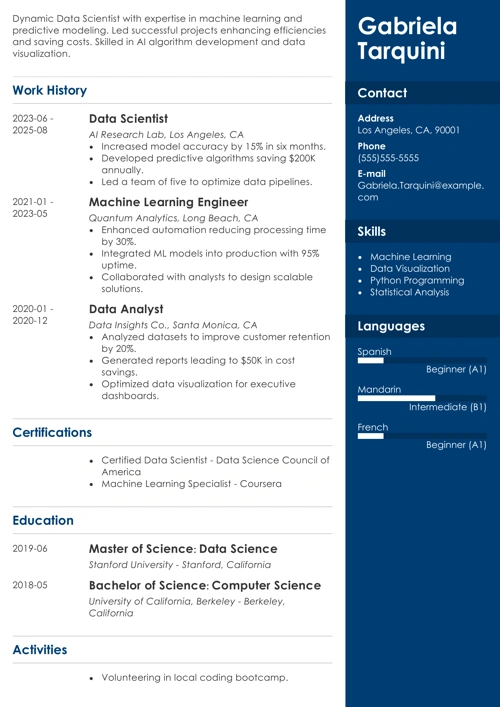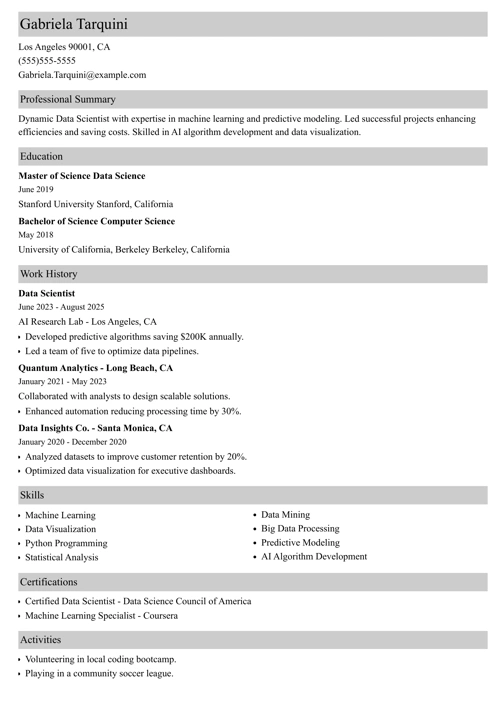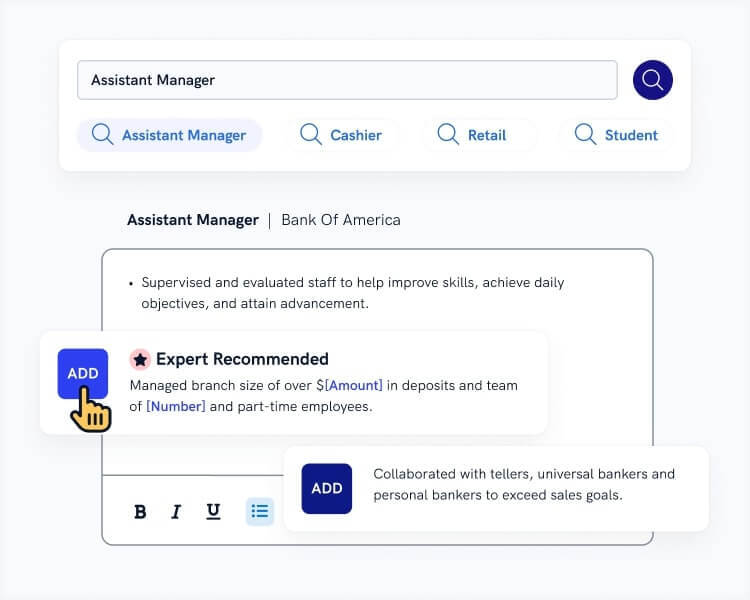If you think writing your data science resume in COBOL will impress the recruiter, I must correct you: it won’t. But there’s a way to show your data science skills and send a resume to wow your future employer.
Read on and see how to write a data scientist resume that will win you your next job interview.
This guide will show you:
- A data scientist resume example better than 9 out of 10 other resumes.
- How to write a data science resume that lands more interviews.
- Tips and examples of applying skills and achievements on a data science resume.
- How to describe your experience on a data science resume to get any job you want.
Want to save time and have your resume ready in 5 minutes? Try our resume builder. It’s fast and easy to use. Plus, you’ll get ready-made content to add with one click. See 20+ resume templates and create your resume here.
Sample Data Scientist Resume—See more resume examples here.
Looking for another position in the information technology field? Visit our guides:
- Computer Science Resume
- Data Analyst Resume
- Data Engineer Resume
- Data Entry Resume
- Business Intelligence Developer Resume
- Information Security Analyst Resume
- Informatica Resume
- IT Resume
- Tableau Developer Resume
- Program Analyst Resume
- Best Resume Examples for All Types of Jobs
Data Scientist Resume Example
Gabriela Tarquini
Data Scientist
546-293-2230
gabriela.tarquini@email.com
linkedin.com/in/gabriela.tarquini
Summary
Proficient Data Scientist with over 5 years of experience leveraging data-driven insights to drive business improvement and optimize overall performance. Seeking employment as a Data Scientist at Innovaris Sphere Solutions to apply my strong problem-solving skills and strategic thinking to help drive informed business decisions. Developed and implemented a predictive model that achieved a 20% improvement in accuracy when predicting client behavior.
Work Experience
Senior Data Scientist
SwiftCore Dynamics, Aurora, IL
July 2016–Present
Key Qualifications & Responsibilities
- Leveraged large data sets to improve business strategy and performance.
- Collaborated with cross-functional teams to implement predictive models.
- Improved client behavior prediction accuracy by 20% by developing and implementing strategic models.
- Presented data-driven insights to executive leadership.
Key Achievement:
- Developed a predictive model that improved the accuracy of client behavior prediction by 20%.
Data Scientist
EpsilonByte Co., Aurora, IL
June 2013–June 2016
Key Qualifications & Responsibilities:
- Assisted in developing algorithms and predictive models to extract and analyze large volumes of data.
- Collaborated in cross-functional teams to implement data-driven strategies.
- Contributed to achieving business goals by providing data-driven insights.
Key Achievement:
- Participated in developing a predictive model that drove a 15% increase in business efficiency.
Education
Master’s degree in Data Science
University of Aurora, IL
September 2010–May 2013
Relevant extracurricular activities
- Head, Student Data Science Association
- Member, University Technology Advisory Committee
Skills
- Problem-solving skills
- Strategic thinking
- Proficient in Python, SQL, and R
- Data visualization and communication
- Advanced predictive modeling
- Teamwork
- Analytical thinking
- Excellent time management
Certifications
- Certified Data Scientist, Data Science Council of America, 2013
Awards
- 2018, Data Scientist of the Year, SwiftCore Dynamics
Memberships
- Member of the Association of Data Scientists since 2013
- Presented a lecture on "Predictive Analytics in Business Strategy" during the 2017 Data Science Conference, Chicago.
Languages
- English—Native
- Spanish—Advanced
Interests
- Volunteering for Code for America: Using data skills to improve community services
- Teaching weekend data science classes at the local community center
Now, learn how to personalize the example to match your needs or how to write an equally fantastic data science resume from scratch:
1. Format Your Data Scientist Resume Template the Right Way
As a data scientist, you must pay great attention to detail. There’s a perfect way of showing you’re capable of doing that early on your resume. How? By choosing the right resume outline.
Here’s how to format a resume for a data scientist:
- Select the right resume format. I always advise going for a reverse chronological, as it’s the one preferred by most recruiters.
- Follow the resume structure below:
- Resume Header (including your contact details)
- Summary Statement or Career Objective
- Work Experience
- Education
- Skills
- Additional Sections
- Choose a professional resume font.
- Keep the correct resume margins.
- Save your document as a PDF resume format unless the job offer states otherwise.
- Name your resume correctly. Your Name + Data Scientist + Resume will always do the trick.
I always advise using a clean, professional data science resume template to let the contents speak for themselves. If that approach sounds good to you, you can choose a sleek, minimalist resume template and not worry about the design any longer.
Pro Tip: Consider adding the address of your optimized LinkedIn profile to the resume header, but first, make sure it’s up-to-date and error-free.
2. Describe Your Work Experience on a Data Scientist Resume
Did you know that the employment of data scientists is projected to grow 36% in the upcoming years? That’s way faster than the average for other occupations. But that also means you must create a resume that stands out to get a job that’s better than most. Now, focus on its most important part: the work experience section.
Here’s how to make it shine:
- Show your experience in the right order, with your current or most recent job at the top.
- Include the job title, company’s name, location, and dates of your employment.
- Add up to 6 bullet points detailing your key achievements.
- Quantify these achievements for a better impression, showing your impact on the companies you worked for.
- Start each bullet point with a resume action word to create a document that’s a great read.
Let’s see some examples:
Data Scientist Resume Examples—Experience Section
| Right |
|---|
Senior Data Scientist SwiftCore Dynamics, Aurora, IL July 2016–Present Key Qualifications & Responsibilities
Key Achievement:
|
| Wrong |
|---|
Senior Data Scientist SwiftCore Dynamics 2016–Now
|
The first example has it all: good power words, quantifiable achievements, and a proper header. The second one lists only duties and not achievements. See how weak it makes it?
But what if you don’t have a lot of achievements to show? There's a way to create a good resume with no experience, even for data scientists.
Data Scientist Resume Samples—No Experience
| Right |
|---|
Freelance Data Science Projects January 2023–Present
|
See? With no work experience, this candidate nailed their resume. Trust me, almost anyone can make a good data scientist resume like that. Just come up with examples of:
Learn more about creating a complete resume. Visit our guide: How to Make a Resume
Making a resume with our builder is incredibly simple. Follow our step-by-step guide, use ready-made content tailored to your job and have a resume ready in minutes.
When you’re done, Zety’s resume builder will score your resume and our resume checker will tell you exactly how to make it better.
3. Highlight Education on Your Data Scientist Resume
The education section matters more for entry-level data scientists. However, that doesn’t mean senior data scientists should neglect it in their resumes. It can easily give any candidate some advantage over their competitors.
Here’s what to include in your data scientist’s resume education section:
There are also some other things you can add, especially if you’re writing an entry-level resume:
- Extracurricular Activities
- High GPA Score (that’s 3.5 or higher)
- Latin Honors
- Dean's List
- Relevant Awards
- Abroad Studies
Let's see these tips in action:
Data Science Resume Examples—Education Section
| Right |
|---|
Master’s degree in Data Science University of Aurora, IL September 2010–May 2013 Relevant extracurricular activities:
|
| Wrong |
|---|
BS in Statistics, Syracuse University 2008 - 2012
|
The first example plugs into the job description like a NoSQL query. The second one, on the other hand, does it all wrong. The GPA is too low to highlight, and bragging about completing all core coursework proves there’s really little to brag about.
Still learning? There’s a way to show it on your resume: How to List Continuous Learning on a Resume
4. Present Relevant Skills on a Resume for a Data Scientist
We’ve gone through experience and education, so let’s focus on the key skills on your resume. The demand for data science skills is growing rapidly, so now it’s your time to shine. You need to combine your hard and soft skills on a resume to impress the recruiter. But… You don’t want to include all the skills you have!
So, how can you do it right?
- Write down all your competencies (hard skills as well as soft skills.)
- Revisit the job ad and see which skills they’re looking for.
- See which qualifications overlap—these are your resume skills!
- Include up to 10 skills on your resume.
Let’s see what it might look like:
Data Scientist Skills on a Resume—Examples
- Problem-solving skills
- Strategic thinking
- Proficient in Python, SQL, and R
- Data visualization and communication
- Advanced predictive modeling
- Teamwork
- Analytical thinking
- Excellent time management
Below you’ll find a list of data science skills to get you inspired.
Data Science Skills for Resumes
Data Analysis | R Programming | |
Mathematics | Python | |
Statistics | NoSQL | |
Data Visualization | Hadoop | |
OpenRefine | ||
Quantitative Analysis | TensorFlow | |
Perceptiveness | Machine Learning | Matplotlib |
Generating Hypotheses | Debugging | Cloudera |
Modelling | PERL | |
Probability | VB |
Based on an analysis of 11 million resumes created using our builder, we discovered that:
- Data Scientists usually list 27.0 skills on their resumes.
- The most common skills for Data Scientists are statistical analysis, Python programming, machine learning, SQL databases, and big data analytics.
- Resumes for Data Scientists are, on average, 2.8 pages long.
5. Boost Your Data Scientist Resume With Extra Sections
Additional sections on a resume for data science jobs will set your document apart from dozens of possible candidates who want to land the same job that you're after. Choose from:
- Certifications and Licenses (such as GCP, CHDA, or CAP)
- Hobbies and Interests
- Volunteer Work
- Industry Awards
- Language Skills
- Conferences
- Publications
- Memberships
Let these examples inspire you:
Data Scientist Resume: Examples of Other Sections
| Right |
|---|
Certifications
Awards
Memberships
Languages
Interests
|
| Wrong |
|---|
Hobbies
|
It’s clear how relevant the first example is compared to the completely irrelevant second one. Remember, when it comes to your additional sections, always stay relevant.
Learn more about things to include on your data scientist resume. Read our guide: What to Put on a Resume
6. Summarize Your Qualifications With a Resume Profile
Since your recruiter might receive 100+ resumes, you might want to make their job easier. There’s no better way of doing that than including a great resume profile. But before I’ll show you some examples, let’s figure out which type is best for you.
- If you have plenty of experience, the resume summary is your best option. It highlights your professional background and work experience.
- If you’re new to the data science field, the career objective is a choice to make. It focuses on your skills, knowledge, and career goals rather than your past expertise.
Now, no need to reinvent the wheel. I’ll share two great formulas you can use:
- Data scientist’s resume summary
Adjective + Data Scientist + Years of Experience + Achievements + Skills + What You Want to Do for the Employer
- Data scientist’s resume objective
Adjective(s)/Certificate(s) + Your Job Title or Degree + seeking employment as a Data Scientist at + Company Name + to apply my + Your Relevant Skills + to help + What Do You Want to Help the Company Achieve
Let’s see real-life examples of data scientist’s resume profiles:
Data Scientist Resume—Examples of Resume Summaries
| Right |
|---|
| Proficient Data Scientist with over 5 years of experience in leveraging data-driven insights to drive business improvement and optimize overall performance. Seeking employment as a Data Scientist at Innovaris Sphere Solutions to apply my strong problem-solving skills and strategic thinking to help drive informed business decisions. Developed and implemented a predictive model that achieved a 20% improvement in accuracy when predicting client behavior. |
| Wrong |
|---|
| Data scientist with 5 years experience seeks new position. Skilled in statistics, machine learning, critical thinking, and data visualization. |
The first one is simply perfect. No wonder: it follows my formula 100%! The second one, on the other hand, is very vague, so not impressive at all.
Entry-Level Data Scientist Resume—Examples of Resume Objectives
| Right |
|---|
| Junior data scientist with 3+ years of experience in project and freelance work. Beat 200+ statistics professors and big data professionals in an NCAA pool, by building models that fit the problem best. Skilled in machine learning, statistics, problem-solving, and programming. |
| Wrong |
|---|
| I am an entry-level data scientist seeking a machine learning or data engineering job. Although I have no real-world experience yet, I'm eager to get into the Big Data field. |
Once again: relevancy and concrete examples vs something very vague.
Need a guide to set up that job-winning professional website for a data analyst? See this guide: How to Make a Professional Resume Website
7. Complement Your Resume With a Cover Letter
Recruiters do read cover letters. So don’t waste that extra chance of explaining further why you’re the best candidate for the job.
Here’s how to write a cover letter for data science jobs:
- Use the right cover letter format and a template that matches your resume.
- Start a cover letter in a way that intrigues your recruiters. Do it by mentioning some relevant and impressive achievements.
- Once again, quantify these achievements.
- Finish your cover letter with a powerful call to action and a professional sign-off.
Plus, a great cover letter that matches your resume will give you an advantage over other candidates. You can write it in our cover letter builder here. Here's what it may look like:
See more cover letter templates and start writing.
Key Takeaway
Now you know how to write a solid data scientist resume, complete with certifications. Remember these key tips:
- Use a reverse-chronological resume format, and include key sections like the header, work experience, education, and skills. Save your data science resume as a PDF and name the file properly for a professional touch.
- Present your experience with clear job titles, responsibilities, and quantifiable achievements using action verbs. If you don’t have formal experience, include freelance projects or academic work.
- Include your degree, coursework, and any relevant extracurricular activities. If you’re a new graduate, emphasize a high GPA or honors.
- List up to 10 skills, focusing on the ones that overlap with the job description. Balance hard skills with soft skills.
- Add certifications, industry awards, memberships, publications, and relevant volunteer work to strengthen your candidacy.
- Write a data scientist resume summary or resume objective.
- Send a compelling cover letter that highlights key achievements, adds context to your experience, and invites the recruiter to learn more about you.
Read more resume guides that might interest you:
- Power BI Resume
- Web Designer Resume
- Network Engineer Resume
- ETL Developer Resume
- Machine Learning Resume
- Network Administrator Resume
- SSRS Resume
- Programmer Resume
- Web Developer Resume
- Bioinformatics Resume
- Science Resume
- Analyst Resume
- System Administrator Resume
- SQL Developer Resume
About Zety’s Editorial Process
This article has been reviewed by our editorial team to make sure it follows Zety's editorial guidelines. We’re committed to sharing our expertise and giving you trustworthy career advice tailored to your needs. High-quality content is what brings over 40 million readers to our site every year. But we don't stop there. Our team conducts original research to understand the job market better, and we pride ourselves on being quoted by top universities and prime media outlets from around the world.




